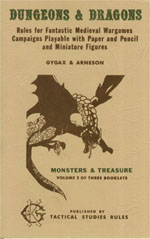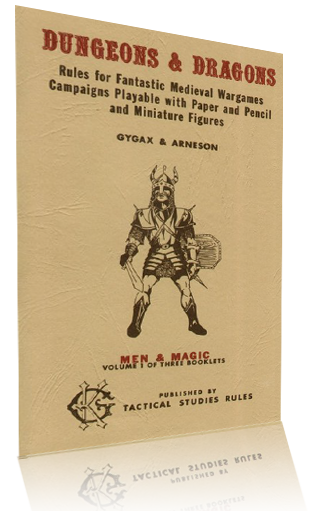 Before I even began to read the OD&D rulebooks, I made a resolution: For this one-shot I was going to use the rules from the original 1974 Dungeons & Dragons game and nothing else. I referred to it as “White Box Only”.
Before I even began to read the OD&D rulebooks, I made a resolution: For this one-shot I was going to use the rules from the original 1974 Dungeons & Dragons game and nothing else. I referred to it as “White Box Only”.
The conceit I was working from was this: What would I do if it was 1974 and all I had in front of me were these three books? What game would I make of it?
To a very real and large degree, of course, this is impossible. I have 20 years of experience and professional expertise in playing and creating roleplaying games.
But one of the interesting things about the OD&D rules is that they are, basically, a set of typeset house rules. There are notable passages which are literally nothing more than a description of how you can kit-bash your copy of TSR’s Chainmail and Avalon Hill’s Outdoor Survival into a semi-cohesive system.
Nor is there any way to actually play OD&D “by the book”. Not only are multiple options frequently given for accomplishing the same thing, but sometimes the rulebooks just flat out contradict themselves. In addition, while Dave Arneson is widely recognized as the original innovator of D&D-style gaming, it’s fairly clear to me that Gary Gygax was in large part responsible for the writing of these rulebooks. And while I will praise Gygax for many things, the man was never skilled at writing or organizing rules — which means that even when there is only one rule for a given situation it will often be written so vaguely as to leave itself open to a myriad of equally valid interpretations.
The result is something like a palimpsest. The OD&D rules are the ur-document of all roleplaying games, but the game itself has no true identity: There is nothing you can point to and say, “That is OD&D.” It is like the many-faced Vishnu: All things at once. A form in formlessness.
As the years passed, the many-formed aspects of OD&D were slowly refined in a particular direction until it became the game that I started playing in 1989 and have (more or less) been playing ever since. But what’s fascinating to me is that there was no particular reason why it was that particular mix of playing styles that were formalized. It could have just as easily been another.
To take a simple example, OD&D presents two options for resolving combat: One is to simply use the Chainmail miniature rules. The other is the Alternative Combat System presented on pg. 19 of “Men & Magic”.
Now, I don’t “have” the Chainmail miniature rules. (I do, actually, but, again, I’m playing “White Box Only”.) So that leaves me with the Alternative Combat System. Here’s the entirety of that system:
ALTERNATIVE COMBAT SYSTEM:
This system is based upon the defensive and offensive capabilities of the combatants; such things as speed, ferocity, and weaponry of the monster attacking are subsumed in the matrixes. There are two charts, one for men versus men or monsters and one for monsters (including kobolds, goblins, orcs, etc.) versus men.
All attacks which score hits do 1-6 points damage unless otherwise noted.
All base scores to hit will be modified by magic armor and weaponry. Missile hits will be scored by using the above tables at long range and decreasing Armor Class by 1 at medium and 2 at short range.
These three paragraphs are accompanied by the two attack matrices mentioned in the text. These matrices function by looking up the Armor Class of the target and cross-referencing it with your level (as a man) or your HD (as a monster). The result is the “Die Score to Hit”.
That’s it.
(What constitutes “medium” and “short” ranges, by the way, are never specified. Nor is it clear which matrix NPC humans should use — they’re men, but there is at least one passage elsewhere in the books which suggests, without outright stating it, that NPC humans in dungeons are considered to be monsters.)
My first impression upon reading these combat mechanics is one of simultaneous declaration and resolution. There’s really nothing that says that, but there’s also no initiative system. And no mention of combatants alternating their actions. So that’s the way I’ll be running it.
And D&D could have gone that way. But instead it went the other direction: Chainmail had a simple initiative system (with each side rolling 1d6 and the higher result electing to go first or second) that would eventually be refined, expanded, and revised into the 1d20 + initiative modifiers system that we have today.
That’s just one example, but the game is filled with this kind of stuff.
In the interests of full disclosure, I’d also like to point out that this is a slightly simplified take on the matter. There actually are other combat rules in the game: The “Underworld & Wilderness Adventures” booklet contains more complicated systems for Aerial Combat and Naval Combat, and some of the rules from these systems could logically be extrapolated out and applied to the Alternative Combat System, the Chainmail rules, or both.
The “Underworld & Wilderness Adventures” booklet also contains this passage on pg. 25:
LAND COMBAT:
The basic system is that from CHAINMAIL, with one figure representing one man or creature. Melee can be conducted with the combat table given in Volume I or by the CHAINMAIL system, with scores equalling a drive back or kill equal only to a hit. Battles involving large numbers of figures can be fought at a 20:1 ratio, with single fantastic types fighting separately at 1:1 or otherwise against but a single 20:1 figure.
This passage has been interpreted by some (but not all) to mean that you one must use the Chainmail rules and that the Alternate Combat System from “Men & Magic” is only meant to be an alternative set of combat matrices for use with the Chainmail rules.
The really fun part? That section on “Land Combat” comes immediately after a multi-section breakdown on player-run Baronies. Because of the unclear layout of the books there have been some who have concluded that this “Land Combat” section is properly understood to be used only when commanding troops on a battlefield.
Others would point to its position immediately preceding the “Aerial Combat” and “Naval Combat” sections and say, “Malarkey.” But that’s my point: OD&D doesn’t really exist. It’s a mirage.
It’s as if someone took the rules for a dozen different variants of Chess, tossed them in a blender, and published the result. People would take this mish-mash and, through one means or another, assemble a playable game out of them. All of them would be recognizable as “Chess”, but the identity of the game we would refer to as “Chess” wouldn’t properly belong to any one of them.
Or perhaps it’s more like being chained in Plato’s Cave. The platonic ideal of “the original Dungeons & Dragons” is dancing in front of a fire behind us, but each of us sees our own pattern of light and shadow cast upon the wall.
And there certainly is something exciting about digging my way through these rulebooks. It’s almost like being on an archaeological dig and trying to reconstruct broken shards of pottery. I can understand the thrill some people feel in doing this and I can understand why it liberates them: When there is no objective rulebook — when the rulebook itself requires through its own inadequacy that you revise it and refine it before you can ever use it — then there are really no limits with what you can do to it. I mean, the first thing I want to do when reading through these booklets is to start trying to revise everything, organize it, and make it fit together in a logical, coherent, and usable fashion.
But, of course, that would defeat the entire point of the exercise.














